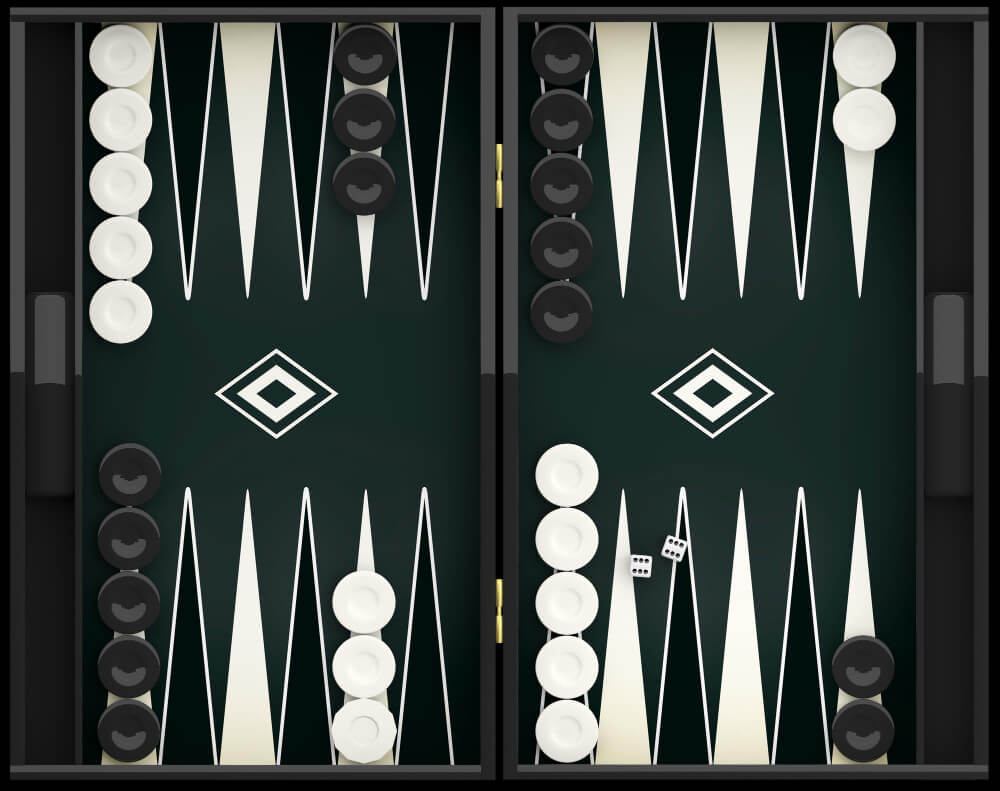Backgammon is an ancient board game that has been played for centuries. The game is widely popular today, and it’s easy to learn the basics of backgammon rules.
Backgammon is a two-player board game that involves strategy and luck. The game is played on a board divided into four quadrants, with 24 triangular points that alternate in color and are numbered from 1 to 24. The points are connected by a bar that divides the board into two halves. Each player has 15 pieces, which are called checkers, and they are placed on the board according to a specific pattern.
Backgammon equipment
- The board:
- 30 pieces – 15 of each color.
- 2 dices.
- Doubling cube.
Backgammon setup
The game starts with each player having 15 pieces arranged on the board in the following way:
One player will use the black pieces and the second will use the white pieces (the colors represent this example)
To begin playing backgammon, each player rolls one die, and the player with the highest roll goes first. Then the play alternates.
The layout of the backgammon board includes 24 narrow triangular points, called points, in four quadrants:
Backgammon object
The basic object of the game is for players to remove all their pieces off the board before their opponents do – the first to do it is the winner!
To remove all the pieces off the board, the player must first move all his pieces into his home base, for example:
After a player successfully moves all his pieces to his home base, he can start removing pieces from the board. Later in this article, we are going to talk about the backgammon removing pieces rules – also called bearing off.
Each win gives the winner points and the first to reach the accepted number of points wins the all game.
Backgammon movement rules
Pieces can only be moved forward along the board toward your inner home base, so the black pieces can move:
:
The white pieces can move only forward in the opposite direction:
To move all the pieces to the home base backgammon have rules. After a player rolls the dice he can move the pieces according to the following rules:
- players need to move by each dice number, for example, if a player rolls 2 and 4, he needs to move the piece 2 and then 4, or 4 and then 2, otherwise is illegal.
- A player can move more than one piece in a single turn.
In the following example, the player rolled 2 and 4, so he move one piece 2 and a different piece a 4.
To clarify, he can’t move two 4’s.
- Pieces can only be moved to open points on the board, which are points that are not occupied by two or more of the opponent’s pieces. In the following example, the specific piece can’t be moved 5 because the point is not open:
- The following kind of move is legal:
It means that the player can close a point for his opponent.
- Pieces can’t be removed before all pieces in the home base:
- Dice can’t be summed up. As mentioned above, a piece can be moved only by each dice number, which means dice can’t be summed up into one big move. For example, if a player rolls 1 and 2 he can’t make a big move of 3:
Of course, if a player rolled 3 this move is legal.
In this example, the piece can’t be moved, so the player must choose another piece to move:
- If a player can’t move any piece the opponents get another turn until a move is possible.
- If a player has the option to move a piece, he has to do it! Even if only one of the dice.
Doubles
Backgammon also features doubles where both dice are matching numbers. For example, if you roll two twos. This means you can choose pieces to move up to four times as many points as shown on the dice.
For instance, a double three would allow a single piece to move up 12 points along with other possible combinations moving different numbers of points with other individual pieces according to what was rolled totals available move values add up too!
Another visual example:
Hitting and Entering from the bar
If your piece lands on a point where there is only one of your opponent’s pieces then they will be sent back to their bar which is essentially like being sent to jail:
To release pieces from the bar a player needs to roll the dice and hope for numbers that indicate open points at the opponent’s home base. in the following example, 3,5,6 are close points, 1 and 4 are open points and 2 is also an open point – which will send the black piece to the bar.
Once a piece is released from the bar it needs to go all the way back to your home base – so be careful!
A player must release his piece before playing with another piece.
In the following example, a player rolls 6 and 4 and only the 4 is an open point, so he must move the piece to this exact point. after releasing all the pieces he can play the 6 regularly:
In the following example, the player can’t release his piece from the bar because of bad dice.
If a player can’t release his piece the turn goes back to the opponent until he does:
There is no limit on the number of pieces that can be on the bar. Both players can have pieces on the bar at the same time:
Backgammon bearing off rules
As mentioned above the way to win the game is by removing the pieces from the board (bearing off).
Firstly, a player must move all his pieces to his home base, after that the removing starts, the player rolls the dice and plays accordingly:
- A player can remove a piece that is on a point that matches one of the numbers of the dice, for example, if the player rolls 3, he can remove the piece that is on point 3 in the home base:
- If the dice numbers are lower than what the player needs in order to remove, the player must move the pieces regularly, look at this example:
The player has pieces on 4,5,6 and he rolled 1 and 2, so he must move 1 and 2 ( or 2 and 1 ).
- A player can move and then remove:
- If the dice numbers are higher than what the player needs in order to remove, the player removes the closet larger number:
Notice that the player can remove the largest number that exists after 6 (the number the dice indicate), in this case, is 3. So one piece of the 3’s can be removed. 2 and 1 can’t be removed in this case! If there were no 3’s, one of the 2’s can be removed.
- If the player rolled the exact number for removing and there are no larger pieces, he must remove it! for example:
The player must remove the 4’s piece. If there was a 5’s or a 6’s piece the player can choose between removing the 4’s piece and moving the 5’s or 6’s.
- Pieces of both players can reach the bar even if the player started removing already.
- Once the player’s piece reaches the bar while the removal has started, the player needs to stop removing and bring back the piece to the home base. When he managed to do it, he could continue the removal.
- The “removing” part of the game is called “bearing off”.
Doubling cube
The doubling cube is used to increase the stakes of the game and speed up games by allowing players to offer each other a double. It’s an optional rule that speeds up play, though it isn’t necessary for a full game of Backgammon.
Gammons and Backgammons
- Regular wins happen when one of the players manages to bear off all his pieces before his opponent does – The winner gets 1 time the value of the doubling cube.
- Gammon’s win happens when one of the players manages to bear off all his pieces before his opponent starts to bear off his pieces – The winner gets 2 times the value of the doubling cube.
- A Backgammon win happens when one of the players manages to bear off all his pieces before his opponent manages to move all his pieces from the bar or from the opponent’s home – The winner gets 3 times the value of the doubling cube.
The popularity of backgammon has grown exponentially over recent years due in part to its simple yet addictive gameplay mechanics and variety of strategies involved in outsmarting opponents with perfect rolls and strategic decisions alike; plus being able to enjoy fast matches or longer ones depending on preference makes it a great option for anyone looking for exciting entertainment whether alone against computer AI or friends online / offline! A Backgammon win happens when one of the players manages to bear off all his pieces before his opponent manages to move all his pieces from the bar or from the opponent’s home – The winner gets 3 times the value of the doubling cube.
FAQ
The objective of Backgammon is to move all of your checkers off the board before your opponent does. This requires strategic planning and luck with dice rolls.
Backgammon is a two-player game.
When a player lands on a blot, they capture the opponent’s checker and send it to the bar. The opponent must then move the captured checker back onto the board before making any other moves.
The doubling cube is a cube with the numbers 2, 4, 8, 16, 32, and 64 printed on its faces. It is used to increase the stakes of the game by doubling the current value of the game.
Some strategies for playing Backgammon include building a strong position on the board, blocking the opponent’s checkers, and using the doubling cube to gain an advantage.






